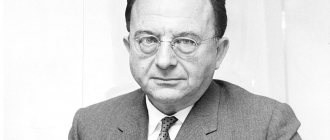“EXTRAORDINARY PSYCHOTHERAPY” AND ITS CREATORS
Jay Haley is in many ways the creator of the legendary figure Milton Erickson. His book “Extraordinary Psychotherapy” was a rare success and not only introduced Ericksonian practice, but brought many people into psychotherapy. Unencumbered by respectable psychotherapy degrees, he graduated from college as a librarian and became involved in the famous project in Palo Alto, where he studied communication in normal and pathological conditions under the direction of Gregory Bateson in the postwar years.
From there it was not far to the then little-known Milton Erickson, with whom Haley spent many years, working and communicating very closely. Hours of conversations, transcripts of tape recordings, observations, reflections... Jay Haley was first and foremost a researcher who was trying to practice.
The independence of his professional views and the brightness of his position made him a hooligan in the eyes of many. His ex-wife, Clu Madanes, one of America's leading family therapists, raised in the psychoanalytic tradition, recalled that she had long refused to meet her future husband, outraged by his Don Quixotic battles (not yet fashionable) with the “mills” of psychoanalysis. Therapy was “long” at the time, and “short” came after a long history, part of which was due to Hayley’s efforts. In Russia, we often forget about this, having immediately received the first and last pages of this difficult chronicle.
Jay Haley came to psychotherapy, which seemed boring and ineffective to him, and became a “knight of the exception to the rule” - a knight of the order, where Erikson was the Grand Master - the Master whom he himself recognized and whom he forced others to serve.
Erickson was an experienced psychiatrist and knew well how a clinical case should “proceed” according to the “rules of good manners” adopted in psychiatry, and just as calmly ignored this knowledge, allowing changes in the patient’s life and his fate - exceptions to the rules. The number of exceptions multiplied throughout his long life, but the rules remained.
Jay Haley, apparently, was not bored with Milton Erickson. One of the confirmations is this book - in some way a wall newspaper, where Haley wrote down his notes and thoughts about his teacher and colleague over the years.
Jay Haley has devoted many years to researching family therapy. He published the magazine “Family Process” and actually contributed to the “family process” of an entire professional field. He worked with Salvador Minuchin in Philadelphia, ran his own institute together with Clue Madanes, and trained more than one generation of psychotherapists. A former librarian, he became an encyclopedist and the author of many books.
Its genre is truly short, unexpected, solution-oriented psychotherapy. And there is something about him from a magician who is about to pull a “rabbit” out of his hat - a serious client complaining about real problems.
In person, Haley seems graceful, a little timid, a little distant—as if she were behind a transparent glass wall. The impression is all the more surprising because it is produced by a man who made so many walls permeable and “passed” through them.
With his life and career, he proved that exceptions can be made the rule, and deservedly takes his place on the professional Olympus.
Leonid Krol
The first principle of working with people according to Erickson
Everything is ok with people. It says that every person can develop and change throughout his life. Each level of development achieved is a support for further personal growth. With the process of personal growth, different points of view and visions of the situation arise, with the help of which we can analyze everything that happens and learn lessons. Knowing that at every moment of life everything is OK with us, we see a little more than we saw before, that is, we go beyond the usual, the former. Based on this, we have options to choose from.
INTRODUCTION
I met Milton G. Erickson, M.D., in 1953 while attending his seminar on hypnosis. The last time I met him was in 1980, shortly before his death. Over the years, I spent hundreds of hours with him researching hypnosis, human relationships, and psychotherapy. No one influenced my views about man and the possibility of changing him more than Erickson. Times have changed. In the fifties, Erickson was considered an eccentric and an outsider, known primarily for his use of hypnosis. His approach to treatment was unusual and contradicted everything generally accepted in therapy at that time. In the last years of his life, he was already the founder of the largest psychotherapeutic school; a huge number of people came to him. His methods were used everywhere, although his ideas did not change - the time had simply come for them. Erickson's methods replaced the disappearing traditional ones.
His supporters, once considered heretics, are now extolled to the skies. And today, more than ten years after his death, Erickson's influence continues to grow.
I would like to briefly describe aspects of psychotherapy that were generally accepted in 1950. For each point, Erickson proposed the opposite approach.
Hypnosis: yes or no?
Hypnosis as a subject was not included in the training program for psychiatrists and was essentially prohibited. It was only in the late fifties that the American Medical Association recognized its right to exist.
Erickson used hypnosis throughout his professional career and recommended it for widespread use in psychotherapy. He conducted training seminars
ry illegally and only on weekends. His students were mainly psychotherapists and dentists, while psychiatrists could not attend these courses without consequences for their reputation.
Today, hypnosis is a generally accepted method, it is used by many practitioners, and this happened precisely thanks to Erickson’s ideas.
Long term or short term?
Psychotherapeutic treatment was long-term, virtually endless. It was common for the therapist to tell the client that no changes should be expected within a year. Often, during treatment, the client was instructed to postpone important life changes - marriage, career advancement. The psychotherapist who provided short-term therapy was condemned. Short-term therapy, in the opinion of the majority, was superficial and only “covered up” the problem without solving it. Long-term treatment led, in turn, to illness. Patients bragged to each other about the number of years they had spent in psychotherapy.
Erickson sought to make the treatment as short as possible and at the same time effective. He talked about many cases of healing that occurred in one single meeting. As a rule, he met with the client once a month or even less often, since he believed that change did not depend on the regularity of therapeutic meetings. Often therapy smoothly transitioned into correspondence with the client if he moved to another city. Erickson did not believe that less work was accomplished in a few sessions than in months or years of regular meetings. By the way, there is still no data proving the greater effectiveness of long-term therapy compared to short-term therapy.
Today, psychotherapy has taken the direction in which Erickson went. Long-term therapy is losing ground and seems to be disappearing. It's not just the theory that has changed. Insurance companies are forcing therapists to learn quick and effective methods. And the main source of such mastery is the legacy of Erikson.
Directive or non-directive?
Psychotherapists were reluctant to give advice or direction to clients. They interpreted or repeated the client's statements. By 1950, Erickson had already developed and used a wide range of directives - direct and indirect. He gave advice and difficult-to-follow instructions to individual patients and entire families.
Today, therapists are forced to learn to give instructions, since modern psychotherapy is developing in this direction. Erickson's legacy remains one of the few sources for both standard procedures and original developments in this field.
frying pan handle
Following tradition, psychotherapists did not focus on the client's problem. They believed that a problem was only a symptom, a manifestation of something deeper. Attention should have been focused on the deep roots of the problem, and not on the problem itself. The therapists believed that the symptoms should not be alleviated, since they were a manifestation of some hidden process that just needed to be worked on. Often after treatment the symptom remained, but it was felt that it was no longer as distressing to the client as before.
Erickson worked with an observable problem. He once said, “A symptom is like the handle of a frying pan. If you grab the handle properly, you can do a lot with a frying pan.” He believed that clients would cooperate more easily with a therapist who worked on what they were paying money for—getting rid of their problem. Today, psychotherapy tends to focus on the client's problem. Modern therapists learn to explore the symptom and change it, rather than look for what is hidden behind it. To conduct short-term therapy, the therapist must achieve improvement in the client's condition as quickly as possible. The time for leisurely reasoning is over. However, to this day, Erickson remains the main source of knowledge on how to cure a symptom in the shortest possible time.
Should we be neutral?
Orthodox psychotherapists were neutral. They avoided having personal influence on the client or being personally involved in the healing process. Seeking to be a "screen" onto which the client could project his insight, they considered the therapist's personal involvement to be a sign of psychopathology. With an impenetrable look, they sat out of sight of the patient and spoke in a monotonous voice, thereby protecting him from their influence. When Harry Stack Sullivan proposed that two people participate in therapy and each reacts to the words of the interlocutor, he was thrown out of the stable in disgrace.
Erickson used himself as a tool to influence the client. He convinced, begged, joked, demanded, threatened, made phone calls - that is, he did anything to achieve the goal of treatment. He argued that personal interest and participation were the main drivers of the healing process, and his diagnoses were always related to real people in the real world, and not to their psychotherapeutic projections. Today, therapists are trying to determine the extent of personal participation in treatment and are coming to the understanding that short-term, problem-solving therapy cannot be neutral and detached.
Past or present?
Traditional psychotherapy up until the fifties focused on the client's past. The implication was that the person acquired the problem because of past programming. The phobia was a result of past trauma. Anxiety attacks were subject to past experience. It was believed that a symptom is a maladaptive behavior formed on the basis of past experience. The situation in the present, as a rule, was not relevant. For example, a wife felt unhappy in her family life because she projected her past experiences onto her husband. Therefore, the therapist did not try to understand what, exactly, was happening in her family at the moment. He never spoke to her relatives on the phone and even less often invited them to his place for a conversation.
10
Erickson, of course, took into account the client's past experiences, especially when using hypnosis to alleviate or change a traumatic experience. But beyond this, he believed that every symptom has a function in the present, and therefore, to change the problem, he sought to influence the client's current relationship system. He was always ready to meet with relatives, spouses or the whole family if he felt that this was necessary for the benefit of the matter.
Today, therapists, especially short-term therapists, focus primarily on the present rather than the past. In fact, phobia specialists do not even ask the patient about the past or find out about his old traumas. The main position of family therapy today boils down to the following: the symptom has the function of adapting a person to the current social situation, and in order to eliminate the symptom, it is the situation that must be changed. Erickson's legacy is a resource for therapists seeking ways to change relationships in the present.
"Good" and "bad" subconscious
Orthodox psychotherapy believed that human motivation was based on subconscious drives. The subconscious was understood as a certain reality filled with negative aspirations and ideas and deeply buried hostile impulses. The client's motivation was believed to be a struggle between conscious control and subconscious aggressiveness trying to break free. The diagnostic interview was aimed at studying the negative aspects of the patient’s personality and identifying subconscious impulses that require release. The therapist's primary tool was interpretation, which was necessary to identify the client's thoughts and feelings that were too frightening to remember.
Erickson suggested looking at the subconscious as a positive force. By following this force, a person wins. Erickson often cited the example of a centipede, which unconsciously used its forty legs perfectly, but got into trouble while trying to consciously follow the process of walking.
11
would. Erickson emphasized trusting your intuition and not being afraid to follow subconscious urges. For example, if he lost something, he considered it the “work of the hands” of his subconscious - and indeed, the thing was found as soon as it became needed for something important. From this position, the purpose of the diagnostic interview was to explore the positive aspects of the unconscious. The client was encouraged to continue doing what he was already doing to solve the problem, because the freed subconscious mind would lead him in the right direction. Erickson did not interpret manifestations of the unconscious. On the contrary, he sometimes instilled amnesia in the client so that he could forget painful experiences or remember them in a controlled, non-frightening form.
Conclusion
For every problem in traditional psychotherapy, Erickson proposed a solution that was the opposite of what was generally accepted at the time. He used hypnosis when no one else did; worked using short-term therapy methods when the only therapy was long-term; gave directive instructions when non-directive therapy was fashionable. He worked with the problem, while others only worked with what was hidden behind it; he was not a neutral observer, but a participant in the patients' lives; he relied on the present more than on the past; he viewed the unconscious as a positive force whose impulses must be encouraged. All these provisions are now not only recognized, but also widely used in medical practice. From an original and an outsider, Milton Erickson became a central figure in psychotherapy.
Milton Erickson: biography
At the end of the nineteenth century, the parents of a famous psychotherapist moved to Nevada with the aim of mining silver and gold.
The famous psychotherapist Milton Erickson was born there on December 5, 1901. He went to school in Wisconsin. Studying was not easy for him due to dyslexia. In 1919, after graduating from high school, Milton contracted polio. This infection affected all the systems of his body, and doctors predicted that he would have a short life, spent only in a supine position. Having a large supply of time, the future famous scientist spent it on memories and training the senses that are responsible for perception. He spent months mentally developing the movements he needed to look out the window, pick up a spoon, and so on. Less than a year after his entire body was paralyzed, Milton Erickson could already come to the University of Wisconsin on crutches. Hard physical work led to the fact that after two years the young student could already walk without crutches, limping slightly, his body weight also increased, and all problems with the spine were resolved. Carefully studying the works of Luria and other psychotherapists, Erickson, based on his feelings, derived many principles in working with people using hypnosis and simply counseling.
At the age of 50, Milton Erickson was overtaken by post-polio syndrome, after which he was able to regain only partial strength. He spent his remaining years in a wheelchair and died at 78.
Milton Erickson's principles are still actively used in medicine and psychology, helping people find peace of mind. He was not only fond of hypnosis, but also believed in the power of the subconscious, to which he gave the lion's share of recovery and change in a person's personality.
Contrary to all forecasts
Of course, the young man was still very weak, although he was recovering. But the fact that he spent most of his time in bed helped him draw a conclusion about the meaning of a person's nonverbal signals. His only occupation was observing his household. Every day he understood body language better. In order to restore motor activity, Milton began to use the “muscle memory” technique. He watched his little sister learn to walk and began to imagine himself controlling his own body. This helped, and soon he began to move his arms and speak. The future psychiatrist wanted to start walking again at all costs. So he came up with the idea that his body needed a shake-up. Then he “made” a thousand-mile canoe trip alone. This technique helped, and Erickson got to his feet.
The second principle of the psychotherapist
Focusing on... Consciousness limits our ability to analyze information. We perceive much more with our subconscious. Using certain techniques, Milton turned the conversation so that a person could better recognize and understand his feelings, and make the right choice for him in this situation. After this, the client gains inner strength, self-confidence, and ceases to need the advice of outsiders.
Erikson's Fourth Principle
Positive intention in behavior. This principle states that every human action is based on good intentions. At a certain moment, we have specific needs that we satisfy with the help of certain forms of behavior. After a while, we may no longer understand why we made a particular decision or acted in one way or another. But if we believe that every action has a positive intention, Milton Erickson argued that we will reach a new level of understanding, entailing a change in personality.
Psychotherapist techniques
Milton Erickson's techniques in the practice of hypnosis are widely used in many countries around the world. By developing in others a positive attitude towards themselves and the whole world, he improved his therapeutic techniques in working with clients. There are several well-known Ericksonian trance induction techniques.
- Say “Yes” - during the conversation, the psychotherapist uses statements with which the client constantly agrees, lulls his vigilance, and he also answers “yes” to a statement with which he may not agree.
- Breaking a pattern is behavior that is unusual in a particular situation. The interlocutor is confused, and the psychotherapist gives instructions that the client accurately follows.
- Chatting. This technique is used by gypsies. The psychotherapist pronounces a set of words, jumping from one topic to another. A person, trying to understand the meaning, gets lost, his consciousness cannot cope with the flow of information, at this time instructions for action go directly to the subconscious.
- Overload - double guidance. Two people stand on different sides in relation to the client, gesture, touch and chatter him. All modalities become overloaded (auditory, kinesthetic and visual), consciousness turns off.
- Triple helix. This technique was actively used by its author, Milton Erickson. Quotes, stories, and messages are used in it, but the first two are not told to the end, interrupting in the most interesting place. The third story with instructions for behavior is told to the end, then the second and first ends. The person enters a light trance.
Indications for use
The use of shock therapy has not been approved by therapists and is controversial .
This is his only technique that is not taught. Hypnosis can help people with mental addictions, disorders and psychological problems.
Here is a list of some results:
- weight loss;
- addiction;
- relationship;
- OCD;
- phobias;
- anxiety;
- anesthesia;
- habit control.
There are a wide range of professionals who use aspects of hypnosis in their work, such as psychologists, psychiatrists, family therapists, and nurses.
Erickson's methods are often used successfully in clinical settings by psychoanalysts , but are not strictly limited to this. Nurses, business leaders, politicians, and even yoga instructors have benefited from incorporating hypnosis into their work.
Meditation and even leisure activities are forms of self-hypnosis . Stage and street hypnosis is a form for entertainment purposes only.
A general depiction of the hypnosis stage shows the hypnotist wearing a silly hat, waving a pocket watch, and instructing the subject to fall asleep by snapping his fingers. It is believed that hypnosis is also present here, but in fact this is a veiled fake.
How is it different from classical hypnosis?
Erickson's position differs from conventional hypnosis in several different ways .
While the process of hypnosis is usually conceptualized in terms of questions from the therapist issuing standardized instructions to a passive patient, Ericksonian hypnosis emphasizes the importance of an interactive therapeutic relationship and the purposeful engagement of the subject's internal resources and experiential life.
Dr. Erickson revolutionized the practice of hypnotherapy .
His psychotherapy is about providing access to a person’s internal resources in order to eliminate both psychological problems and pain problems.
This scheme is based on contact and joint work between the psychotherapist and the client .
The new psychotherapeutic strategies that Dr. Erickson used in his treatment of individuals, couples, and families stemmed from his hypnotic orientation.
Although he was known as the world's leading hypnotherapist, Dr. Erickson used formal hypnosis in only one-fifth of cases in clinical practice .
Dr. Erickson brought about a fundamental shift in modern psychotherapy. Many elements of Erickson's perspective that were once considered extreme have now been incorporated into modern practice.
Help with advice
But Erickson's interests were not limited to the possibilities of hypnosis. He was interested in pedagogy, communications, and psychology. The famous English anthropologist Gregory Bateson invited him to be a consultant. He had made the film Trance and Dance in Bali and wanted Erickson to evaluate his work. Bateson introduced Erickson to other famous psychiatrists. A book, Unusual Therapy, was written about Milton's work. Its author was Jay Haley, who was a student of Erickson and later founded the Institute of Family Therapy in Washington. This book brought Milton popularity. He gained followers and students. He began conducting educational seminars and trainings and did this all his life.










